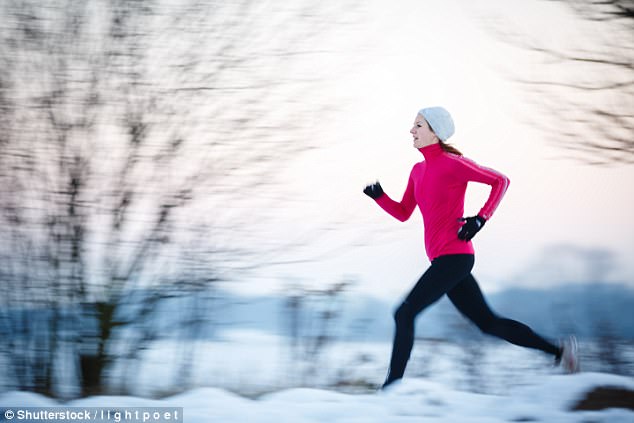You really can shiver off the calories this winter, according to personal trainers and exercise physiologists, according to Daily Mail.
The body’s primary goal is to maintain stasis, or stability, and that includes keeping a steady temperature.
So, in the cold, the body needs to burn extra fat, to produce energy to heat it back up to the ideal temperature.
But there’s a trick to it, and personal trainer Max Zeumer spoke about his surprisingly fun tips for how to optimize your cold weather workout.
Why shivering makes you burn calories in the cold
During the winter, the body ramps up its production of a chemical called ATLPL, which helps it to store up fat for the evolutionary scarce season, so staying active in the winter is important to counteracting that.
What’s more, with the right workout plan, you can take advantage of your shivers, says Zeumer.
When you work out in the cold, ‘your body will work really hard to stay warm and burn a ton of calories to do it, but that really only starts when you’re shivering,’ he says.
The cold acts as a ‘thermal stressor,’ forcing the body’s temperature regulation out of wack, says Jason Castano, a trainer.
To keep the core, vital organs at the right temperature, blood flow to the extremities is reduced, and kept concentrated closer to the heart and internal organs.
The heart rate and metabolism slow, trying to save up energy and keep the warm blood in place.
That’s when the shivering starts. Those shakes are a series of fast muscle contractions and releases, a way for the body to produce some extra warmth by burning energy stored in fat.
Once you get into a relatively consistent, high intensity workout – though you’ll feel like you’re working harder at first, against your slower heart rate and metabolism – the body begins warming up from more robust fat burning.
As your heart rate rises, blood and warmth return to your hands, feet and other extremities, and shivering is no longer necessary.
Once you hit that point, you’re burning calories as you would during exercise at any temperature.
Even a GENTLE walk outside can burn fat
There’s a simple solution to finding the right balance, Zeumer says.
‘If you want to burn a couple of extra calories, just walk outside. It sounds funny, but it will add up,’ he said.
Walking in moderately warm clothing on a cold day will keep your heart rate from getting high enough to cancel out the shivers, but is enough activity to require burning some fat for energy.
Zeumer says that a short walk to lunch is a good way to burn off calories (before you sit down and indulge in some more).
Shivering into shape isn’t the only opportunity an winter workout offers, however.
‘There are a lot of cool things about working out outside during the winter, when you’re inside a lot more often,’ Zeumer says.
‘Indoors, you’re not exposed to sunlight, which means you’re not getting enough vitamin D. When you’re not getting enough vitamin D, your simple carb cravings are increased,’ he explains.
You also store those carbohydrates more when you don’t spend time out in the sun.
Vitamin D helps to break down simple carbohydrates in sugary foods like juice, cookies and other baked goods.
‘Outside, you get vitamin D, which you really need since you have a deficit in the winter. It will reduce those sweet cravings, plus improve your serotonin, which both makes you happier and will boost your immunity,’ Zeumer says.
Perhaps the ‘coolest thing’ is the workout plan he recommends: sledding.
Why SLEDDING is the optimal winter workout
‘You sled down the hill, then take advantage of that hill and run back up. The sledding acts as your rest period, then you get your heart rate up going back up the hill,’ Zeumer says.
‘You kill two birds with one stone: it’s a fun activity, and you get your winter workout in,’ he adds.
It’s essentially the perfect winter interval training. Plus, the snow naturally makes it more likely you’ll shiver off some extra calories.
‘Your body temperature will be a lot lower because you’re closer to the cold while you’re playing in the snow, making your body really fight to stay warm,’ he says.
If you want to supplement your sledding routine with a more traditional workout, Zeumer says to do a warm up followed by high-intensity body weight training.
‘If you want to work out more outside, layer up for your warm up, with a jacket over a hoodie, then, after your warm up, take off the jacket so you’re in just your hoodie.
‘You won’t be freezing, but still able to burn extra calories’ by shivering he says.
For your high intensity workout, try one to two minutes each of pull ups, push ups, body weight squats and planks. Take as much as two minutes of rest in between sets, and do up to five rounds.
In the cold, you’re less likely to notice normal signs of dehydration.
‘You won’t sweat as much so you won’t realize how much water you’re losing, but those risks are still very real when you work out in the cold,’ Zeumer says, so don’t forget a water bottle – and a thermos of hot cocoa to warm you back up after.
N.H.Kh

